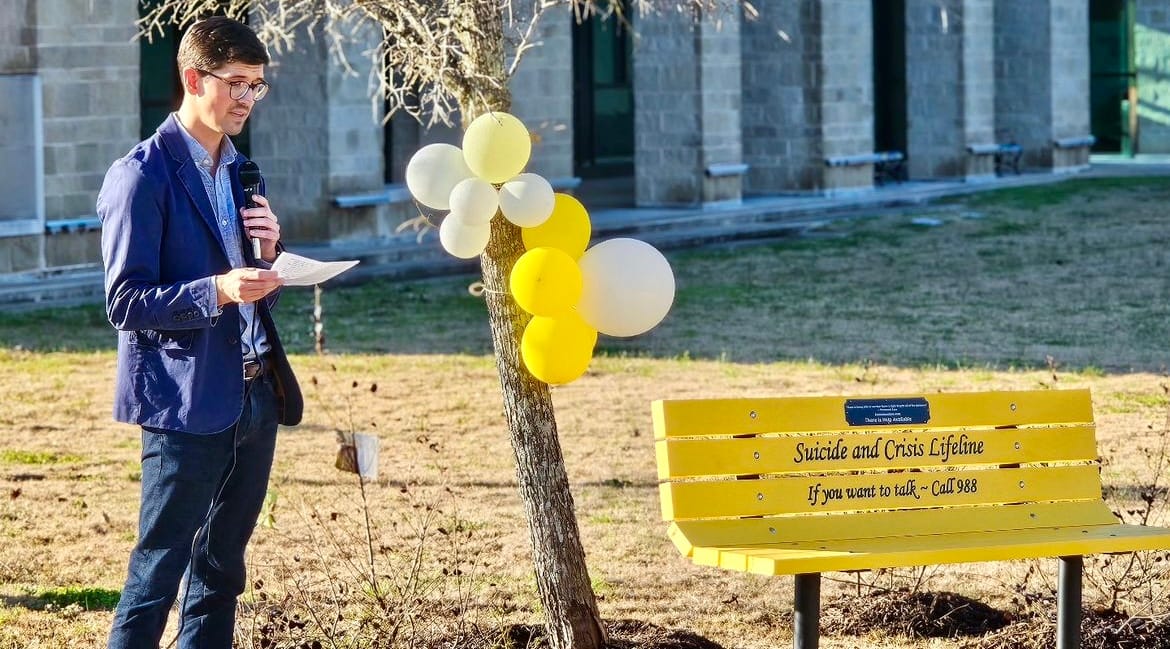Josh's bench UHCL dedication speech
This semester, UHCL became home to a new installation from the Josh's Bench organization. The organization installs yellow benches with crisis line numbers in an effort to decrease mental health stigma and prevent suicides.
We place our benches in public parks and schools because we want to show people that their community supports them through their struggles.
I was honored to be asked to give a brief speech at its unveiling ceremony. You can read what I put together below.

January 25, 2024
University of Houston Clear Lake
I went to a small high school of 400 students—that is 400 total, not 400 per grade (real small compared to the schools here in Houston—in an isolated town of about 10,000 people. When I was a senior, there were a cluster of youth suicides at our school. Each student had their unique struggles, each from different cliques. Our community was shocked and devastated. Each of us was asking: What is the solution to a community in so much pain? The answer, I believe, is community itself. Community, reaching out to each other, showing each other that we are not alone, that we are not a burden, can be tremendously powerful. This bench is a physical reminder that we are in community and that help is available.
How to help, of course, is not always clear and there is never one solution to a wicked problem like suicide. But there are several things the data has shown us over the years. The first is that genuine connection, a helping hand, a voice on the crisis line, matters. This bench is a beautiful reminder of this. Second is that treatments for suicide are not all created equal, some are, in fact, far more likely than others to be helpful. The three treatments with the best evidence are dialectical behavior therapy, brief cognitive-behavioral therapy for suicide prevention, and CAMS, the collaborative assessment and management for suicidality. Communities, together, can demand more access to these treatments. Lastly, we can help make the environment safer for people in crisis. In the US, where most suicides are gun deaths and most gun deaths are suicides, this means helping people and their families decrease access to their firearms while they are in crisis (much like we work to remove access to someone’s car keys when they are drunk).
If you’ll allow it, I’d to close with another brief story—that of Marsha Linehan. Linehan was a psychologist and quite successful academic. She developed Dialectical Behavior Therapy (DBT for short), what was, and still is, one of the only treatments with actual scientific evidence of helping suicidal people. Near the height of her career, she gave a major address at the Institute of Living – a prominent psychiatric institute in Connecticut. Instead of laying out her many achievements or discussing the latest scientific data, she shared that this was not her first time at the Institute for Living. That as a teen, she had been institutionalized at the Institute for nearly two years and was described by the physicians as one of the most severe patients there. This was part of how she knew what was going to be needed to successfully treat highly suicidal people—because she had been there herself. She made a vow that she would get herself out of the hell of pain she was in and find a way to get others out of hell too. She did that with DBT.
But Marsha is adamant that DBT is not a suicide prevention program. The goal is not merely keeping people from killing themselves. The goal is to help others build lives they experience as worth living. And that is all our task as well. To help others build lives they experience as worth living. To find relief from the pain, yes, but to also move toward what they see as a valued life. May this bench be a reminder that connection helps build lives worth living.
Thank you.
